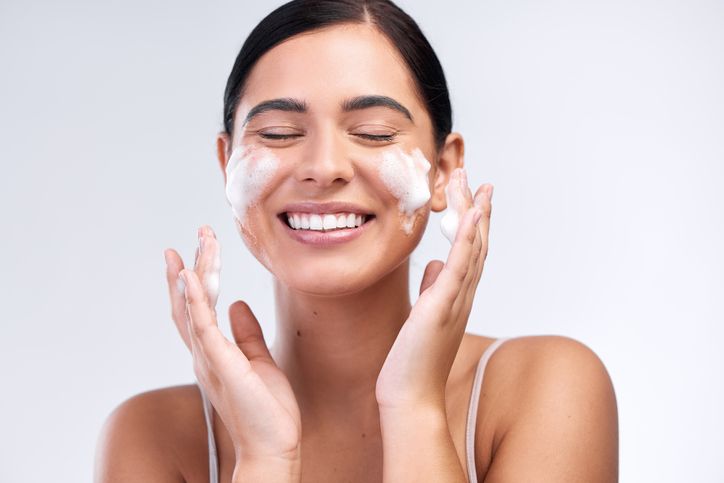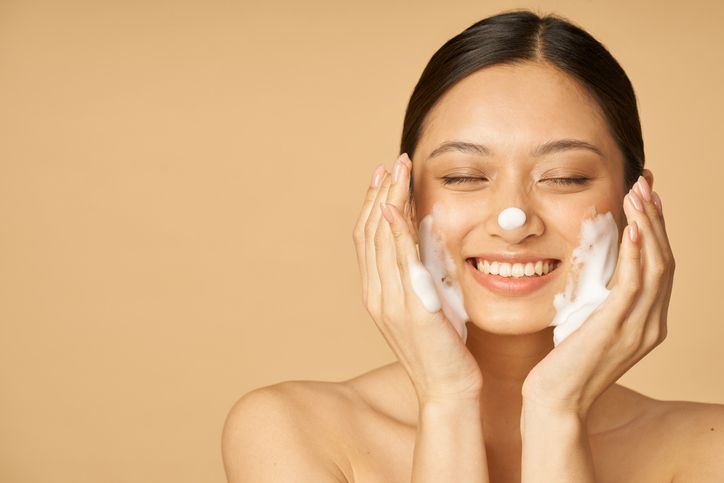- Home
- Trend
- Weight Loss Strategies
- Acne Tips
- Hair Health Information
- Blemish Removal Tips
- Acne Scar Removal Tips
- Muscle Building Techniques
- Intimate Care Tips
- Postpartum Intimate Care
- Eye Bags Wiki
- Tips for Face Slimming
- Secret of Permanent Hair Removal
- Breast Enlargement Tips
- Cure to Snoring
- Marionette Lines
- Skin-Tightening Secrets
Many people struggling with acne tend to rely on acne creams, acne patches, or herbal teas to “cool down” the body, but they often overlook the importance of facial cleansers. Don’t underestimate the impact of your cleanser — it plays a crucial role in acne treatment. The wrong type of cleanser can easily damage your skin barrier and even worsen your acne. In this article, we’ll take a deep dive into facial cleansers, helping you choose the right product for your skin type to improve your acne.
Why Do We Use Facial Cleansers?

Facial cleansers, also known as cleansing lotions, are primarily used to remove excess sebum, sweat, dust, and other impurities from the face, keeping your skin fresh and clean. Common ingredients in facial cleansers include oil-phase substances, water-phase substances, moisturizers, and surfactants. Some high-end products may even contain nutrients that offer additional skincare benefits with long-term use.
Thanks to the principle of “like dissolves like,” oil-phase components in cleansers can dissolve the oil on your skin’s surface, while water-phase components remove sweat and other impurities. Surfactants further enhance this by providing foaming, cleansing, dispersing, emulsifying, and lubricating effects — boosting cleaning power while minimizing irritation and allergic reactions.
Most cleansers on the market fall into two main types: soap-based and amino acid-based. Generally, soap-based cleansers offer stronger cleansing power than amino acid-based ones. However, when choosing a cleanser, it’s important not to focus solely on how well it cleans. Consider your skin type, skincare habits, and specific concerns to find the best product for your needs.
Common Facial Cleanser Ingredients

When shopping for a facial cleanser, it’s crucial to read the ingredient list. Some ingredients are highly irritating and may not be suitable for everyone. This is especially important for acne-prone individuals — irritating ingredients can easily worsen your acne. Below, we break down some common cleanser ingredients and their potential impact on your skin:
i. Soap-Based Ingredients
These are chemical compounds made by combining fatty acids and alkaline substances. Common examples include potassium myristate, sodium palmate, and sodium laurate. Soap-based cleansers typically have a pH of 8–10, making them strongly alkaline and potentially irritating. While they offer strong oil-removing power and deep cleansing, long-term use can lead to excessive oil removal, damaging the skin barrier and weakening your skin’s natural defense — causing dryness, redness, itching, flaking, and increased sensitivity.
ii. Amino Acids
Amino acids are the building blocks of protein and have a pH similar to human skin, making them gentle and skin-friendly. Common amino acid surfactants include sodium cocoyl glutamate, sodium lauroyl glutamate, and sodium methyl cocoyl taurate. However, many cleansers that claim to be “amino acid-based” may contain only trace amounts of these ingredients — or even mix in soap-based components, which can still irritate the skin. Always check the full ingredient list carefully.
iii. Sulfates
These are strong surfactants found in many cleansing products including facial cleansers, body washes, and shampoos. Like soap-based ingredients, sulfates are highly effective at removing oil but can be harsh on the skin. Prolonged use may damage collagen structures and accelerate aging, leading to fine lines and wrinkles. Common sulfate ingredients: sodium lauryl sulfate (SLS), sodium laureth sulfate (SLES), and sodium stearyl sulfate.
iv. DMDM Hydantoin
Some brands use this ingredient as a preservative. According to environmental health organizations, DMDM hydantoin releases formaldehyde — a known carcinogen that can trigger skin allergies. Regular use can damage skin cells and worsen acne or other skin conditions.
v. Sulfosuccinates
These are gentle surfactants with mild cleansing power, often used as secondary ingredients to regulate foam levels. Though not powerful cleaners, they are less irritating and suitable for dry or sensitive skin types.
vi. Glucosides
Derived from natural plant sources, glucosides are very mild and have low irritancy. However, their cleansing power is limited, so they’re best suited for dry or sensitive skin. Some products use glucosides to offset the harshness of other ingredients. Common examples include alkyl glucoside, decyl glucoside, and lauryl glucoside.
vii. Non-Surfactant Ingredients
These have no cleansing power on their own but rely on the principle of “oil dissolves oil” to help remove excess sebum and impurities. Products with these ingredients are often marketed as makeup removers or non-foaming cleansers.
免費體驗
Acne Treatment
1 Minute Self-Registration
Date should not be before minimal date
Different Types of Facial Cleansers for Different Skin Types
i. Foaming Cleansers
These are the most common cleansers on the market and usually contain surfactants that emulsify oils for deep cleansing. They come in rich-foam and micro-foam types.
Though effective, foaming cleansers can over-cleanse and damage the skin barrier — especially for those with dry, sensitive, or normal skin. Best for oily and combination-oily skin.
ii. Lotion-Type Cleansers
These have a creamy or milky texture and do not produce foam. They contain surfactants and oily ingredients that clean via emulsification and “oil dissolves oil.” Compared to foaming cleansers, lotion types are gentler and less drying — suitable for dry, combination-dry, and normal skin. However, they may not clean oil thoroughly enough for oily skin types, possibly leading to blackheads or acne.
iii. Cleansing Bars
Most cleansing bars contain soap-based ingredients, offering strong cleansing power but also high irritation. Unless you have very oily skin, it's not recommended to use cleansing bars daily. Even for oily skin types, limit use to 2–3 times per week.
iv. Cleansing Creams
These thick, paste-like cleansers offer deep cleansing and help draw out impurities from clogged pores. Best for those with thick skin or excess oil production — such as men or acne-prone individuals. When used in moderation, they can help improve oil control and acne.
v. Collagen Cleansers
These are typically soap-free, making them gentler and less irritating. Many contain hydrating ingredients, making them suitable for sensitive skin.
vi. Scrub Cleansers
These contain tiny exfoliating beads that help remove dead skin cells while cleansing. However, they can be too harsh for daily use.
• Oily skin: use once a week
• Dry, normal, combination skin: once every two weeks
• Sensitive or acne-prone skin: not recommended
90% of People Use Facial Cleansers Incorrectly! Here’s the Right Way
Do you apply cleanser directly to your face and rub it around randomly? That can actually irritate your skin and damage your skin barrier. Follow these steps for a gentle yet effective cleanse:
Step 1: Wash your hands
Dirty hands can transfer bacteria to your face — always clean them first.
Step 2: Wet your face with warm water
Warm water helps open up pores, making it easier to remove dirt and impurities. It also helps your cleanser lather better.
Step 3: Foam the cleanser
Lather the cleanser in your hands before applying. (Skip this if using a non-foaming cleanser.) Apply it to five points: forehead, nose, both cheeks, and chin. Use your middle and ring fingers to spread evenly.
Step 4: Clean your cheeks
Gently massage in circular, upward motions — from chin to earlobes, mouth to in front of the ears, and sides of the nose to temples.
Step 5: Clean your nose
Use your middle and ring fingers to slide from the tip of the nose to the bridge, moving up and down gently.
Step 6: Clean around the eyes
Use your ring finger in light circular motions, avoiding direct contact with the eyes. Light pressure can promote circulation and help reduce dark circles.
Step 7: Clean your forehead
Massage in circular motions from the center outward to the temples.
Step 8: Clean around the mouth
Start from the center of the chin and move upward around the lips to the upper lip, massaging in circles. Finish by lifting the corners of the mouth to enhance facial contours.
Step 9: Rinse thoroughly
Use room-temperature water to rinse off all foam or residue from your face.
Cleanser Alone Isn’t Enough! Combine It With Clinical Treatments for Effective Acne Care
While the type of facial cleanser you use does impact your skin health, it’s not enough on its own to completely eliminate acne. If you truly want to say goodbye to breakouts, you must try Perfect Medical’s Acne Treatment. This non-invasive treatment gently conditions the skin, helping it return to a healthy state and ultimately resolving acne issues.
The treatment begins with vacuum dermabrasion technology, which gently removes surface oil, blackheads, whiteheads, and other debris from the skin and pores, restoring clear and unclogged pores. Once your pores are clear, inflammation and acne can be effectively prevented.
Next, the treatment infuses the skin with Perfect Medical’s exclusive medical-grade hydrating essence, providing deep hydration and helping to balance oil production — a great solution for those with excess sebum. Additionally, the treatment reactivates collagen regeneration, encouraging the skin to repair itself, which helps fade acne scars and improve texture issues like pitted skin.
Most impressively, visible results can be seen after just one session. Completing a full course of treatment can help you say farewell to facial acne once and for all. And as long as you maintain good skincare and lifestyle habits afterward, your acne is unlikely to return.
Right now, Perfect Medical is offering a free first trial session! Just click the link below to claim your offer. What are you waiting for?
Try Now: Perfect Medical Acne Treatment免費體驗
Acne Treatment
1 Minute Self-Registration
Date should not be before minimal date
FAQ

What are the common types of facial cleansers on the market?
Facial cleansers are generally categorized by texture or formula, including foaming cleansers, lotion-type cleansers, cleansing bars, paste-type cleansers, and more.
What are the common ingredients found in facial cleansers?
Typical cleanser ingredients include soap-based surfactants, amino acids, glucosides, sulfates, and moisturizers.
How many times a day should I use a facial cleanser?
While keeping your skin clean helps maintain its health, over-cleansing can damage your skin barrier, leading to various issues. It’s best to cleanse twice a day — morning and night.
How much cleanser should I use each time?
Under normal circumstances, a pea-sized amount of cleanser is sufficient per use. If you have very oily skin, you may use slightly more.
What type of cleanser is suitable for acne-prone skin?
People with acne-prone skin should choose gentle, non-irritating cleansers to avoid worsening their condition. However, if your acne is caused by excess oil production, a cleanser with stronger oil-control properties may be more effective.









